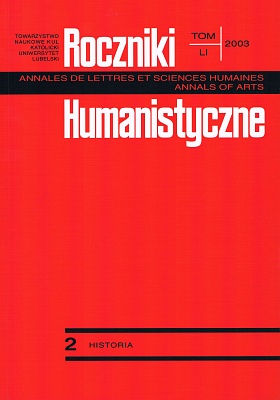Z dziejów Świętego Miasta, I: Jerozolima przed Izraelitami
Abstrakt
The history of the Holy City in the pre-Israelite period is very incomplete, therefore one can hardly gain a thorough knowledge about it. It was plundered and destroyed, then built anew and re-built and then again it rose phoenix-like from the ashes. This phenomenon poses considerable difficulties for historians and archaeologists. Especially the period of the Late Bronze arouses numerous controversies; there are no material traces from this period of the city at all, therefore some scholars conclude that it did not exist then. It seems that this standpoint is too radical. Nevertheless the history of this period should be treated with utmost care, until further evidence has arrived.
Throughout this period Jerusalem was a small town, and did not mean much in the main trends of the history of the ancient Near East. A decisive turn in the history of the town took place ca. 1000 BC (this is approximately the date of the appearance of David), when Israelites conquered it and changed it into their capital. Jerusalem had been transformed into a centre from which were sent orders that influenced the lives of the inhabitants of the whole Palestine.
Bibliografia
Aharoni Y., The Land of the Bible. A Historical Geography, Landon: Burns and Oates 1967.
Auld G., Steiner M., Jerusalem I. From the Bronze Age to the Maccabees (Cities of the Biblical World), Cambridge: The Luttenworth Press 1996.
Barkay G., A Late Bronze Age Egyptian Temple in Jerusalem, IEJ 46(1996), s.23-43.
Barkay G., What's an Egyptian Temple Doing in Jerusalem, BAR 26(2000), nr 2, s.48-57, 68.
Cahill J., It Is There: The Archeological Evidence Proves It, BAR 24(1998), nr 4, s. 34-41, 63.
Cross F. M., Canaanite Myth and Hebrew Epic. Essays in the History of the Religion of Israel, Cambridge: Harvard University Press 1973.
Davis E., Adoni-Bezek, w: En.Jud., t. II, s. 294.
Davis E., Adoni-Zedek, w: En.Jud., t. II, s. 296.
Emerton J. A., The Site of Salem, the City of Melchizedek (Genesis XIV 18), w: Studies in the Pentateuch, red. J. A. Emerton (SVT 41), Leiden: E. J. Brill 1990, s.45-71.
Gonen R., The Chalcolithic Period, w: The Archaeology of Ancient Israel, red. A. Ben-Tor, New Haven and London: Yale University Press 1992, s.40-80.
Kapera Z., Nowe odkrycia w Jerozolimie (1961-1963), RBL 18(1965), s.230-235.
Kempinski A., The Middle Bronze Age, w: The Archaeology of Ancient Israel, red. A. Ben-Tor, New Haven and London: Yale University Press 1992, s.159-210.
Kenyon K. M., Excavations in Jerusalem 1961, PEQ 94(1962), s.72-89.
Kenyon K. M., Excavations in Jerusalem 1962, PEQ 95(1963), s.7-27.
Kenyon K. M., Excavations in Jerusalem 1963, PEQ 96(1964), s.7-18.
Kenyon K. M., Excavations in Jerusalem 1964, PEQ 97(1965), s.1-24.
Kenyon K. M., Excavations in Jerusalem 1965, PEQ 98(1966), s.73-95.
Kenyon K. M., Excavations in Jerusalem 1961-1963, BA 27(1964), s.34-52.
Lebanon A., Jebus, Jebusite, w: En. Jud., t. IX, s.1307.
Margalith O., The Riddle of Genesis 14 and Melchizedek, ZAW 112(2000), s.501-508.
Mazar B., Jerusalem in the Biblical Period, w: Jerusalem Revealed. Archeology in the Holy City 1968-1974, Jerusalem: The Israel Exploration Society 1975, s.1-10.
Mazar B., Jerusalem. The Early Periods and the First Temple Period, History, w: The New EAEHL, t. II, s.698-701.
Mazar E., Ophel Excavations, Jerusalem 1986, IEJ 37(1987), s.60-63.
Mendecki N., Palestyna i Jerozolima w okresie przedizraelskim, RBL 48(1995), s.81-94.
Miller J. M., Jebus and Jerusalem: A Case of Mistaken Identity, ZDPV 90(1974), s.115-126.
Moran W. L., The Hebrew Language in Its Northwest Semitic Bachground, w: The Bible and the Ancient Near East. Essays in Honor of William Foxwell Albright, red. G. E. Wright, Garden City: Doubleday & Company Inc 1965, s.59-84.
Moran W. L., The Syrian Scribe of the Jerusalem Amarna Letters, w: Unity and Diversity. Essays in the History, Literature, and Religion of the Ancient Near East, red. H. Goedicke i J. J. M. Roberts, Baltimore− London: The J. Hopkins University Press 1975, s.146-166.
Na' aman N., It Is There. Ancient Texts Prove It, BAR 24(1998), nr 4, s.42-44.
Na'aman N., The Contribution of the Amarna Letters on Jerusalem's Political Position in the Tenth Century B.C.E., BASOR 304(1997), s.157-173.
Rahmani L. Y., Ancient Jerusalem's Funerary Customs and Tombs. Part Two, BA 44(1981), s.229-235.
Reich R., Four Notes on Jerusalem, IEJ 37(1987), s.163-164.
Rubinkiewicz R., Jerozolima, w: Encyklopedia katolicka, t. VII, k.1185-1193.
Several M., Reconsidering the Egyptian Empire in Palestine during the Amarna Period, PEQ 104(1972), s.123-133.
Shanks H., The Missing Millennium in Jerusalem's Archaeology, BAR 26(2000), nr 5, s.34-37.
Shiloh Y., Jerusalem, the City of David, 1978, IEJ 28(1978), s.274-276.
Shiloh Y., Jerusalem, the City of David, 1979, IEJ 29(1979), s.244-246.
Shiloh Y., Jerusalem, the City of David, 1980, IEJ 30(1980), s.220-221.
Shiloh Y., Jerusalem, the City of David, 1981, IEJ 32(1982), s.157-158.
Shiloh Y., Jerusalem, the City of David, 1982, IEJ 33(1983), s.129-131.
Shiloh Y., Jerusalem, the City of David, 1983, IEJ 34(1984), s.57-58.
Shiloh Y., Jerusalem, the City of David, 1984, IEJ 35(1985), s.65-67.
Shiloh Y., Jerusalem, the City of David, 1985, IEJ 35(1985), s.301-303.
Shiloh Y., Jerusalem. The Early Periods and the First Temple Period, Excavation Results, w: The New EAEHL, t. II, s.701-712.
Smith G. A., Jerusalem. The Topography, Economics and History from the Earliest Times to A.D. 70, t. I-II, Jerusalem: Ariel Publishing House Jerusalem b.r. (reprint z r. 1907).
Steiner M., A Note on the Iron Age Defense Wall on the Ophel Hill of Jerusalem, PEQ 118(1986), s.27-32.
Steiner M., It's Not There. Archeology Proves a Negative, BAR 24(1998), nr 4, s.26-33, 62-63.
Steiner M., Re-dating the Terraces of Jerusalem, IEJ 44(1994), s.13-20.
Strąkowski H., Jerozolima – szkic historyczno-archeologiczny, w: Ze współczesnej problematyki biblijnej (Rozprawy Wydziału Teologiczno-Kanonicznego 27), Lublin: Towarzystwo Naukowe KUL 1961, s.131-154.
Copyright (c) 2003 Roczniki Humanistyczne

Utwór dostępny jest na licencji Creative Commons Uznanie autorstwa – Użycie niekomercyjne – Bez utworów zależnych 4.0 Międzynarodowe.





